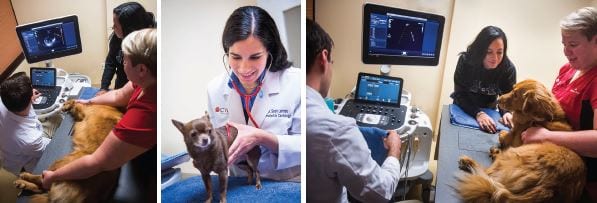How a Board Certified Veterinary Cardiologist Diagnoses Complex Heart Conditions in Pets}
Wiki Article
What You Need to Know About Vet Solutions: An Overview of Diagnostic Tools and Procedures
Vet services play a vital role in keeping the health and wellness of family pets. Regular check-ups can expose covert wellness issues beforehand. Various diagnostic tools and treatments, such as blood examinations and imaging strategies, provide necessary understandings right into a pet's well-being. Recognizing these methods is crucial for pet dog owners. What details diagnostic treatments are most frequently used, and exactly how can they affect an animal's treatment strategy?Value of Normal Veterinary Examinations
While lots of pet dog owners may underestimate the importance of regular vet exams, these visits are vital for keeping a pet's general wellness. Routine brows through to the veterinarian enable early detection of prospective health concerns prior to they escalate into major problems. Routine check-ups commonly include inoculations, which are essential for avoiding transmittable conditions that could drastically influence a family pet's well-being. In addition, these consultations supply an opportunity for vets to examine the animal's weight, oral wellness, and general condition, making certain that the pet dog is growing. During these gos to, pet dog owners can also obtain useful guidance on diet, workout, and precautionary care tailored to their specific family pet's requirements.Usual Analysis Procedures in Veterinary Medicine
In veterinary medication, accurate diagnosis is necessary for reliable therapy. Usual analysis procedures consist of blood screening methods, progressed imaging modern technologies, and urinalysis, each playing a significant duty in determining health issues. Understanding these methods boosts the capacity to offer appropriate take care of pet people.Blood Checking Methods
Blood testing strategies act as crucial diagnostic devices in veterinary medication, enabling veterinarians to assess the wellness of pets accurately. These methods include gathering blood examples to examine numerous parts, such as red and white blood cells, platelets, and biochemical pens. Common examinations include total blood matters (CBC), which review total health and find infections, and biochemical panels, which assess organ function and metabolic condition. In addition, serological examinations can determine specific illness through antibody discovery. Blood screening is minimally intrusive and provides essential information that aids in identifying problems, keeping an eye on health standing, and assessing actions to therapies. In general, these methods play an essential role in making sure excellent look after animals and animals alike.Imaging Technologies Utilized
Analysis imaging technologies are necessary tools in vet medication, complementing blood testing strategies by offering aesthetic understandings right into an animal's interior structures. Typical imaging modalities include X-rays, which serve for examining bone cracks and discovering foreign objects, and ultrasound, which permits for real-time visualization of soft cells and body organs. Magnetic resonance imaging (MRI) supplies in-depth pictures of complex physiological areas, specifically in neurological evaluations. Computed tomography (CT) gives cross-sectional pictures, boosting analysis precision for numerous conditions. Each of these technologies aids vets in identifying illnesses, preparing treatments, and keeping track of recuperation. By integrating imaging technologies, veterinary professionals can much better evaluate an animal's wellness and make informed decisions regarding their treatment.
Urinalysis and Diagnostics
Urinalysis works as a critical analysis tool in veterinary medicine, giving useful insights into an animal's total health and aiding in the discovery of various conditions. This non-invasive procedure evaluates urine examples to evaluate kidney function, hydration standing, and metabolic disorders. Usual parts analyzed consist of certain gravity, pH levels, glucose, proteins, and the presence of blood or germs. Uncommon searchings for can show concerns such as urinary system infections, diabetic issues mellitus, or kidney illness. To boost diagnostic precision, urinalysis is frequently done together with various other tests, such as blood work and imaging studies. Early discovery with urinalysis can lead to prompt interventions, boosting the diagnosis for numerous vet clients. As a result, it is a crucial element of thorough veterinary care.Recognizing Blood Tests and Research Laboratory Analysis
Comprehending blood examinations and lab evaluation is important in vet medication as it aids in identifying numerous health problems in pets. Different kinds of blood tests offer crucial info concerning an animal's internal state, while translating lab results calls for careful consideration of many variables. This section will certainly discover the types of blood tests offered and the value of their results.Kinds Of Blood Tests
Blood examinations play a vital role in veterinary medicine, offering essential insights into an animal's health and wellness condition. Different types of blood examinations are used, each offering various purposes. Total blood counts (CBC) analyze total health and wellness and identify problems such as anemia or infection. Biochemical profiles review organ feature by measuring enzymes and electrolytes, providing insights right into metabolic wellness. Serological tests identify details antibodies or virus, assisting in the diagnosis of infections or autoimmune diseases. Blood typing warranties risk-free look at more info transfusions, while coagulation tests evaluate the blood's ability to embolisms, crucial for procedures. These examinations collectively enhance diagnosis, treatment planning, and surveillance of an animal's health, highlighting the significance of complete laboratory evaluation in vet care.
Analyzing Lab Results
A thorough Learn More Here analysis of laboratory outcomes is vital for exact medical diagnosis and treatment in veterinary medicine. Translating laboratory results needs an understanding of typical referral ranges and the importance of variances. Blood examinations can expose different health signs, such as body organ feature, electrolyte equilibrium, and the visibility of infections. Veterinarians need to consider the entire clinical picture, including the pet's background, checkup searchings for, and any kind of signs and symptoms presented. Variations in results may arise from aspects such as age, type, and underlying wellness conditions. Lab results should not be watched in seclusion yet rather as part of an all-inclusive diagnostic approach. Exact analysis permits for customized therapy strategies and better end results for veterinary individuals.Imaging Techniques: X-rays, Ultrasounds, and Beyond
Imaging techniques are crucial devices in vet medicine, providing vital understandings into the health and health of pets. Amongst one of the most typically used techniques are Ultrasounds and x-rays. X-rays are vital for picturing bone structures, aiding vets identify fractures, lumps, or foreign things. This technique is non-invasive and quick, making it suitable for immediate situations.Ultrasounds, on the other hand, use sound waves to create photos of soft cells and body organs. This method is particularly useful for taking a look at the heart, abdomen, and reproductive organs, allowing vets to analyze problems like fluid build-up or body organ abnormalities.Beyond X-rays and ultrasounds, progressed imaging methods such as computed tomography (CT) and magnetic resonance imaging (MRI) are increasingly made use of in vet technique. These techniques provide thorough cross-sectional photos, boosting the accuracy of diagnoses and treatment plans. Board Certified Veterinary Cardiologist. Generally, imaging techniques play a necessary duty in ensuring effective veterinary careThe Role of Biopsies in Diagnosing Animal Wellness Issues
Precision in diagnosing health and wellness concerns in family pets frequently rests on making use of biopsies, which give definitive information regarding tissue abnormalities. A biopsy entails the elimination of a tiny example of tissue for assessment under a microscopic lense, permitting veterinarians to recognize different problems, consisting of infections, lumps, and inflammatory conditions. This analysis tool is crucial for comparing benign and deadly growths, assisting therapy decisions, and assessing the seriousness of a condition.Biopsies can be carried out utilizing different techniques, such as needle ambition, incisional biopsies, or excisional biopsies, depending on the location and kind of cells involved. The option more info here of method may influence recovery time and the amount of cells collected. Eventually, the info gleaned from a biopsy can bring about targeted treatments, enhancing outcomes for pets dealing with major wellness obstacles. Veterinarians emphasize the importance of this treatment in accomplishing precise medical diagnoses and efficient treatment plans.Advanced Diagnostic Equipment: Endoscopy and CT Checks

Advanced analysis devices, such as endoscopy and CT scans, play an essential duty in contemporary vet medication, providing non-invasive methods to visualize interior frameworks and identify numerous conditions in animals. Endoscopy involves using a versatile tube equipped with an electronic camera, enabling vets to analyze the stomach tract and breathing system directly. This strategy can expose problems such as lumps, international bodies, or inflammation, making it possible for targeted treatment plans.CT scans, on the various other hand, use innovative imaging innovation to produce comprehensive cross-sectional pictures of the body (Cancer Veterinary Near Me). This approach is especially valuable for evaluating facility frameworks like the brain, spine, and joints. By offering high-resolution pictures, CT scans assist veterinarians in recognizing issues that might not appear via traditional radiography. Together, these advanced tools boost analysis precision, enhance therapy results, and ultimately add to much better overall pet dog health and wellness monitoring

Analyzing Examination Outcomes: What Pet Owners Must Know
Understanding examination outcomes can be a difficult job for pet owners, specifically after innovative procedures like endoscopy and CT scans have actually been done. Analyzing these results requires a grasp of clinical terms and a clear understanding of what the findings show regarding the pet's health and wellness. Vets commonly supply explanations, but the complexity of the results can still lead to confusion.Pet proprietors must actively involve in discussions with their veterinarians, asking questions to clear up any type of uncertainties. It is important to understand regular versus irregular results and the implications for the family pet's treatment strategy. Furthermore, acknowledging that some outcomes may need further screening or monitoring can aid owners remain informed about their animal's health journey. Eventually, a collaborative technique between pet dog owners and veterinary specialists fosters far better health and wellness end results and boosts the total care experience for pet dogs.Regularly Asked Questions
Exactly how Do I Pick the Right Veterinary Clinic for My Animal?
Selecting the ideal veterinary center includes investigating regional options, evaluating credentials, going to facilities, and evaluating staff interactions (Board Certified Veterinary Cardiologist). Prioritizing suggestions from trusted sources can help guarantee the very best treatment and setting for a pet dog's wellness demandsWhat Should I Do if My Pet Dog Declines to visit the Vet?
When an animal rejects to go to the veterinarian, it's a good idea to remain tranquil, usage treats or playthings to tempt them, and take into consideration setting up a home visit if anxiousness continues. Patience and favorable reinforcement are essential.Are There Telehealth Options for Vet Services?
Telehealth choices for vet services are progressively readily available, permitting family pet proprietors to talk to vets remotely. These services make it possible for discussions regarding health issues, suggestions on minor ailments, and follow-ups without needing to visit a facility.
Exactly how Frequently Should My Pet Dog Have Oral Check-Ups?
The frequency of dental exams for pet dogs commonly relies on their age and type. Usually, veterinarians recommend yearly oral evaluations, although some animals might need more constant sees to maintain ideal dental health and wellness.
What Are the Costs Connected With Vet Diagnostics?
The costs connected with vet diagnostics can vary commonly, commonly ranging from standard examinations like blood work to innovative imaging techniques. Aspects influencing expenditures consist of the clinic's location, devices utilized, and details tests required for each animal. Veterinary solutions play an important role in maintaining the health of animals. While many animal owners might undervalue the importance of normal veterinary check-ups, these visits are essential for preserving a pet's overall health and wellness. Furthermore, these consultations offer a chance for vets to assess the animal's weight, dental wellness, and overall problem, making sure that the pet dog is growing. Precision in identifying wellness concerns in animals often hinges on the use of biopsies, which give clear-cut details regarding tissue problems. In addition, recognizing that some results may require more screening or tracking can assist proprietors remain notified about their pet dog's wellness journey.Report this wiki page